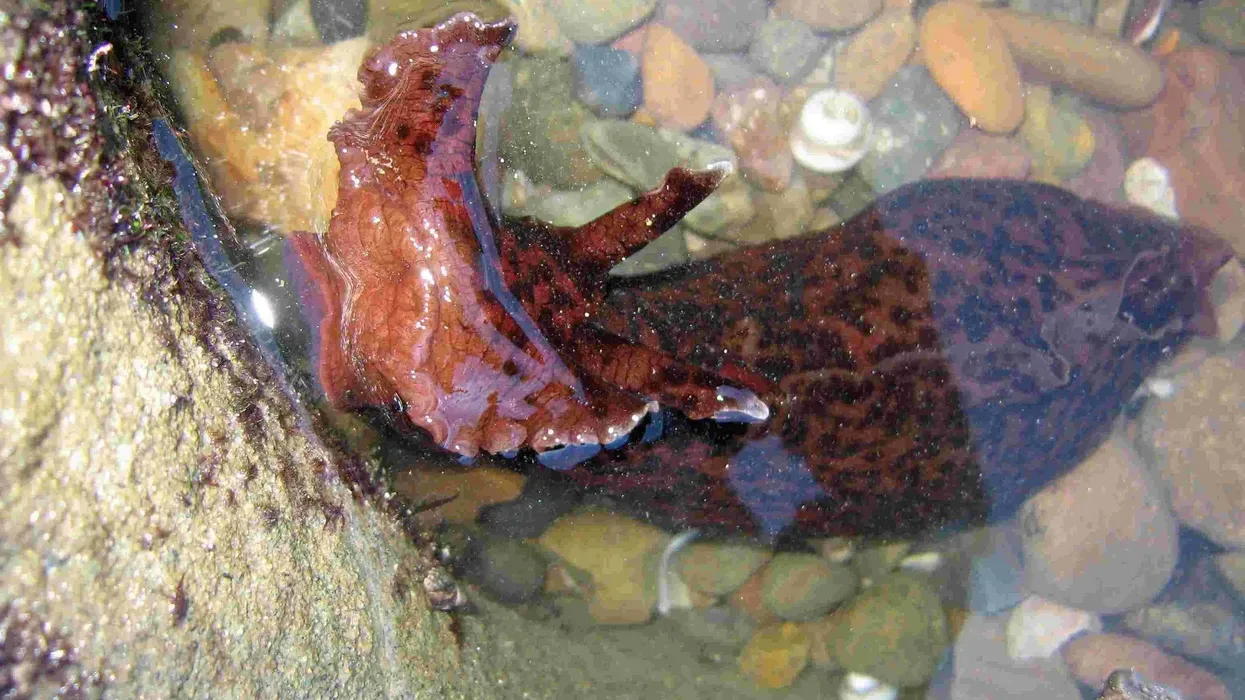Do you like learning about amphibians? Then we have all the information about the California tiger salamander.
The California tiger salamander (Ambystoma californiense) is a rare species of tiger salamander that can only be seen in California. If you wish to see them, you can visit Sonoma County or Central Valley, but don't pick them up or try to take them home. They have been declared as Vulnerable species.
The U.S. Fish and Wildlife Service announced the part of these salamanders living in Santa Barbara County as an Endangered species.
They have a beautiful look to them. They have appealing yellow spots on a body that is black and gray.
If you look closely, you can see 12 coastal grooves on the sides of their bodies. The California tiger salamander mainly lives underground in burrows made by ground squirrels. The adults can be seen hibernating in these underground burrows during the dry months of the year.
Many of them breed only once in their life in their designated breeding pools. Later, the female lays the egg in singles or in small groups.
Read on to discover this amphibian. For more relatable content, check out these fire salamander facts and hellbender salamander facts for kids.
California Tiger Salamander Interesting Facts
What type of animal is a California tiger salamander?
The California tiger salamander (Ambystoma californiense) is a type of salamander that is native to California.
What class of animal does a California tiger salamander belong to?
The California tiger salamander (Ambystoma californiense) belongs to the class Amphibia of animals.
How many California tiger salamanders are there in the world?
The exact number of the population of the California tiger salamander is not known, but it is assumed to be definitely more than 10,000 individuals. However, the total population is very small and declining each day.
The main reason has been said to be habitat loss. The species has lost a lot of its breeding sites, which has lowered its population. Even though it can be said to be common locally, its entire population is on the verge of extinction.
Where does a California tiger salamander live?
The species is native to only California in the United States. The distribution of their populations can be seen in their geographic range in central California.
The population lives in the range of Sonoma County to Santa Barbara County, in the surrounding foothills of Central Valley. They can be seen around the northern range of Tulare County to the southern range of Butte County in the east, and around the north-western range of Kern County to the southern range of Colusa County in the west.
About 80% of these living salamanders live in Madera County, Alameda County, Monterey County, Contra Costa County, Santa Clara County, San Benito County, Merced County.
Around 30% of this population can be found in Alameda County. Records of the salamanders being native to San Mateo County were also found.
What is a California tiger salamander's habitat?
The California tiger salamanders have been found living in hot and dry summer climates and cool and wet winter climates. Their primary habitat includes grassland of the coastal bay area, open forests of foothills. They sometimes find their living space in already made burrows of any ground squirrel.
Who do California tiger salamanders live with?
California tiger salamanders are usually solitary creatures. They only come together when the breeding season arrives. Adults along with young salamanders can be seen staying together at the time of draughts to save their body water.
How long does a California tiger salamander live?
The life cycle of these salamanders is known to be for around 10 years.
How do they reproduce?
The reproduction of the California tiger salamanders may occur only once in their entire life cycle. The adult salamanders gain breeding age at the age of four to five years. The breeding season for the species occurs from late winter to early springtime.
Females can lay up to 1,300 eggs at a time. She either lays the eggs in a small group or in singles.
She may attach a single egg to grass, twigs, or debris. The egg hatches after about two to four weeks. The California tiger salamander larvae are usually yellowish-gray.
What is their conservation status?
The conservation status of the California tiger salamanders according to the International Union for Conservation of Nature is listed as Vulnerable. The California tiger salamander populations are showing a decreasing trend as well.
The U.S. Fish and Wildlife Service has deemed the populations of these salamanders in Santa Barbara County as an Endangered species and the California Department of Fish and Game has yet to change their status and has kept it Threatened.
California Tiger Salamander Fun Facts
What do California tiger salamanders look like?
California tiger salamanders are comparatively large, long-bodied amphibians. They have a broad, rounded snout. Their eyes are small, and their irises are black-colored. The body is usually of black color with a gray-colored belly.
The entire upper body has clear yellow spots which gave the salamander its name 'tiger'. The belly has pale yellow or white spots. Twelve costal grooves can be seen on the sides of their body.
How cute are they?
They can look extremely cute with the yellow spots on their beautiful black and gray bodies. They are also tame in nature, which only increases their cuteness.
How do they communicate?
Not much is known about how the California tiger salamanders communicate. Salamanders in general communicate through touch, and chemical means.
They secrete a type of poisonous chemical to ward off predators. We can assume that the California tiger salamanders communicate in the same manner as well. Some salamanders express their poisonous nature with their bright colors like the bright yellow spots the California tiger salamanders have.
How big is a California tiger salamander?
The males of the adult California tiger salamanders are about 8 in (20.3 cm) and the adult females are about 7 in (17.8 cm) in length. The Chinese giant salamanders, the largest of the salamander species are about six times longer than the California tiger salamanders. Chinese giant salamanders are about 47.2 in (120 cm) in length.
How fast can a California tiger salamander move?
Adults of the California tiger salamander can move at a speed of 0.03 mph (0.05 kph). The juveniles on the other hand move at a speed of 0.02 mph (0.03 kph).
How much does a California tiger salamander weigh?
The exact weight of the adult or juvenile California tiger salamander is not known. Usually, the average weight of a tiger salamander, another species of the same genus Ambystoma, is 0.3 oz (9.4 g). So we can assume that the weight of the California tiger salamander would also be somewhere around the range.
What are the male and female names of the species?
The males and females of the species don't have any specific names.
What would you call a baby California tiger salamander?
When the salamander eggs hatch, they are called larvae. When they become a bit older, the young are called salamander nymphs.
What do they eat?
The adults of the California tiger salamanders eat earthworms and other insects. The youngs on the other hand eat algae, small aquatic invertebrates, tadpoles, and mosquito larvae.
Are they poisonous?
Not much is known about whether the California tiger salamanders are poisonous or not. Tiger salamanders in general secrete a toxic milk-like substance that is poisonous in nature.
Tiger salamanders have tail glands where this poison is stored. The California tiger salamander was once a subspecies of tiger salamanders (Ambystoma tigrinum). Even though they are now a separate species, we can assume that California tiger salamanders have this trait as well.
Would they make a good pet?
Many tiger salamanders are kept as pets, but there has been no record of the California tiger salamanders being kept as pets in a large number. For research purposes, many of the species are kept in laboratories, and they have been recorded acting tamed and friendly with the humans.
However, we suggest not taking them home as the status of their populations is already Vulnerable and decreasing. Taking them away from their natural habitat will only worsen the situation.
Did you know...
It is illegal to import, export, and even keep any kind of tiger salamanders, basically any animal of the family Ambystomatidae in California. You would need a special permit from the California Department of Fish and Game to keep them.
The habit of migrations of the California tiger salamander indicates the species moving to the vernal pools which they use as breeding sites from the underground burrows early in the breeding season. The young ones go through metamorphosis and once they finish metamorphosis, they leave these vernal pools, or breeding pools to live on land.
Why is the California tiger salamander endangered?
Throughout its natural habitat, the species has been deemed either a Threatened, Vulnerable, or Endangered species. Though they are not extinct, their population is showing a declining nature.
The main few reasons why it's decreasing is because of habitat loss due to urbanization and turning their habitat for agricultural purposes, predatory animals inhabiting the vernal pool or breeding sites, or lower availability of the ground squirrel species, so the salamanders don't have available burrows made by the ground squirrel species to live in.
Why is the California tiger salamander important?
California tiger salamanders are important for two reasons. One is for their feeding habits. They are known to feed on insects, tadpoles, and mosquito larvae.
This helps in keeping their population of insects and amphibians under control around their natural habitat. Another reason is their permeable skin. Researchers can study the skin of the species to understand the pollution level in its natural habitat.
Here at Kidadl, we have carefully created lots of interesting family-friendly animal facts for everyone to discover! Learn more about some other amphibians from our Columbia spotted frog facts and spadefoot toad facts pages.
You can even occupy yourself at home by coloring in one of our free printable California tiger Salamander coloring pages.









